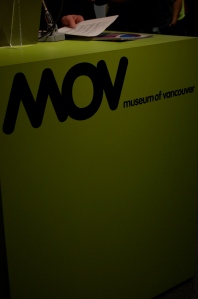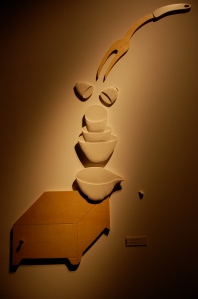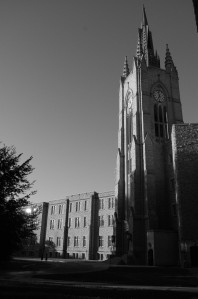Map of Tenderness. Dreaming Objects. First Letter. Whisper.
What images do these words and phrases evoke for you? And why have I chosen them, seemingly out of the blue?
 They’re the titles of some of the pieces on display in the Museum of Vancouver’s Art of Craft exhibit, which launched last week, and I had the good fortune to attend its opening party last Wednesday night with a friend.
They’re the titles of some of the pieces on display in the Museum of Vancouver’s Art of Craft exhibit, which launched last week, and I had the good fortune to attend its opening party last Wednesday night with a friend.
Even though I often bemoan the fact that I can’t quite grasp modern art – especially pieces that reflect elusive minimalism (read: geometric shapes on large, white canvases) – I’m always in awe of the creative spirit that seeps through artistic works of the imagination.
The MOV’s Art of Craft exhibit was no exception: it inspired wonder, reflection, amazement, and, yes, perplexity. (Modern art seems, at times, to be a very unsettling question mark – a beautiful one, of course, but nevertheless a question mark.)
Elegantly laid out, the exhibition leads the viewer through three different galleries. The first is entitled Unity & Diversity. It showcases a wide range of Canadian handiworks recently on display at the Cheongju International Craft Biennale in Korea. The second is called By Hand. It features pieces from BC and the Yukon, and explores the artists’ creative processes. The third represents Craft from the Republic of Korea, and provides the visitor with a glimpse into Korea’s tradition of craftmaking and the directions it is taking.
Although all of the galleries contained unique and thought-provoking pieces, I think I lingered the longest in the first one on Unity & Diversity, perhaps because I was most intrigued by the ideas presented in its opening panel. Printed in large font to the left of the smaller, introductory text were the words of art critic and curator, Rachel Gotlieb. It read as follows:
The absence of a national style for craft may be a good thing for current makers because there is no domineering aesthetic or style to overcome.
The introductory text to Unity & Diversity, into which the above quote is also incorporated, expresses the idea that it is the diverse imaginations and talents of our artists that define Canadian craftmaking, that there is “no such thing as a specifically ‘Canadian’ type of craft.” This seems to be an upbeat, modern approach to a more general – and age-old – lament: that Canada has no national culture to speak of that is uniquely her own.
Rather than bemoan the lack of a dominant aesthetic, the curators of Unity & Diversity stress the strength – and, ironically, unity – that results from the “rich layers of difference” from which Canadian craftmaking is woven. And Gotlieb’s words are a reminder of a positive side that I had not considered before: that the lack of a national style frees up the artist to explore what is on his or her heart – free from the constraint of having to conform to a dominant tradition and free from the impulse to purposely react against it because it is the status quo.
This introductory panel was beautifully written – and the rest of the text throughout the different galleries was too. I’m certain the authors revised countless drafts to get it just right – a balance of scholarly research and audience-friendly language.
 It’s just a pity that very few people, at least the ones I observed, stopped long enough to read it. Many simply threw a perfunctory glance in its direction before walking on eagerly to see the actual pieces.
It’s just a pity that very few people, at least the ones I observed, stopped long enough to read it. Many simply threw a perfunctory glance in its direction before walking on eagerly to see the actual pieces.
Granted, the design and layout might have had something to do with this. Rendered in white on a beige background, the text tastefully – but also unfortunately – blended into the neutral backdrop. Moreover, the panel was placed in a rather narrow part of the entrance to the first gallery, with most of the craft pieces visible only when you turned a corner past the panel. Both the narrow space (not so conducive to reflective pausing & reading on a crowded evening) and the enticing corner (very conducive to suspense: what lies around it?) likely sealed the fate of the opening text panel, however well written…
All of this reminds me of what my Digital History professor had emphasized when we were designing our virtual exhibit on William Harvey last year: that text panels should be the last option when communicating a message because, well, people don’t really like to read in an exhibit setting…they’d much rather interact with the things on display; at the very least, they’d much rather observe them directly without text getting in the way.
I think I’m going to experience museums quite differently now since completing my degree…






